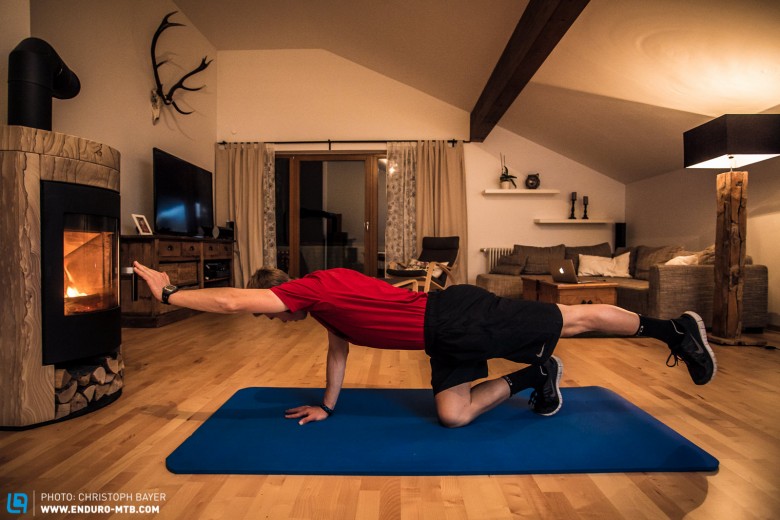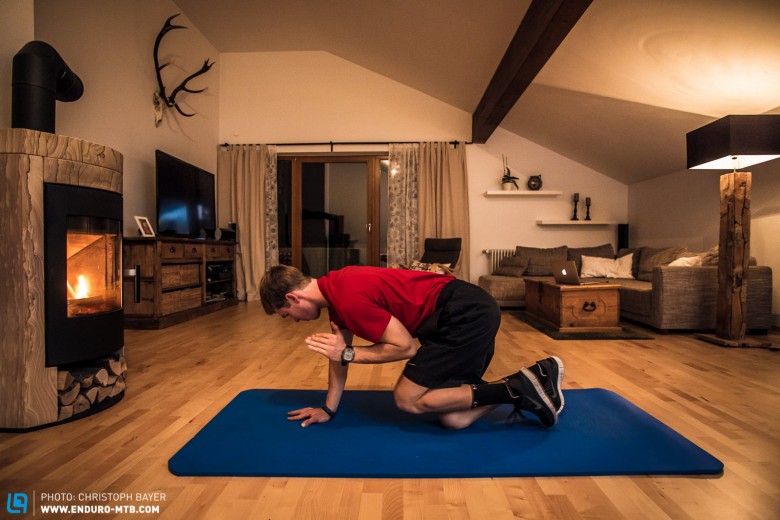In the first part of our new “Ride Fit” series our interview with Michael Kley explained the basic building blocks of a sucessful winter training program. Now its time for the first practical part and we’ll show you five exercises which will increase your core strength and thus provide you with better control on the bike.
A strong core is the basis of every movement on the bike. Regardless of whether climbing or descending: if the deep lying muscles are trained built up as a system the rider can co-ordinate every movement on the bike better. The workout shown here should last about 30 minutes and if possible you should do it twice per week. If you should encounter any pain during the exercises, you need to stop training straight away and in case of doubt consult a doctor.
The most important thing when doing core training is a high level of body tension and precise execution of the exercise itself. In general you should follow this rule: as soon as a movement begins to slip you should take a break and if necessary try out an easier variation of the exercise.

The basics:
Always keep you posture!
That means:
Every exercise must be done with sufficient body tension.
- If your body tension drops and you haven’t reached your target, end the exercise anyway. Fight your way towards the target using your body tension!
- This way the training effect is higher than if you finish the time but with a half of the reps at a bad quality.
Body tension can be achieved before every exercise by:
- tensing your upper legs/thighs
- tensing your buttocks
- tensing your stomach muscles
- straightening out your chest
- and pulling your shoulder blades in and down towards the spine.
Exercise Nr. I – Plank

Starting position:
- Get in the lower arm hold position
- The ellbows are exactly below the shoulders
- Knees and hips are stretched
- Stomach, thighs and buttocks are tensed
- Core and both legs forma straight line (buttocks aren’t dropped or raised!)
- You look straight down (neutral neck position)
How to do the exercise:
In the hold position build up the body tension as if you want to move the elbows towards the foot tips without actually moving them.
Repetitions:
- 6×10 second holds
Changing intensity:
- easier: hold starting position without trying to increase tension betweent he elbows and toes (3 x 30 – 60 seconds)
- harder: 6 x 20 seconds – hold the tension between your elbows and toes
Exercise Nr. II – Side hold position

Starting position:
- Get into the side hold position
- The elbows are aexactly below the shoulders
- Knees- and hips are stretched
- The core is actively moved away from the elbow (the ear is far away from the shoulder)
- Stomach, thighs and buttocks are tensed
- Core and legs form a straight line (looking from above)
- Focus straight ahead (neutral neck position)
Repetitions:
- 3 x 30 – 60 second holds
Changing intensity:

- easier: same exercise as above but the knees are bent so that the knee can support you
- harder: carry out the exercise with movement: in the side position the pelvis moves slowly towards the floor until the legs touch the floor. Then the pelvis is moved back to the starting position.
Exercise Nr. III – Rotational stability in quadruped position


Starting position:
- Get into the in quadruped position on your hands and knees
- The hands are below the shoulders the knee below the hips
How to do the exercise:
- Tense your stomach muscles
- Lift and stretch out your arm and leg on opposite sides
- The core and pelvis stay parallel to the floor
- The knee and and opposite elbow meet centrally below your body
- Lower the knee and elbow and repeat on the other side. Always do the exercise with opposite sides.
Repetitions:
- 3×30 – 60 second repetitions than change the side
Changing intensity:
harder: arm and leg on the same side are lift and stretched. To do this you may shift some weight slightly to the supported arm and leg. Core and pelvis stay parallel to the floor. Knee and elbow on the free side meet centrally under the body.


ATTENTION: this exercise is very demanding, observe the following:
- if the whole core must be turned up so that you are almost in the side-hold position
- if the pelvis is turned up and no longer parallel to the ground
- or if your free hand must repeatedly touch the ground…
… go back to the easier exercise with the diagonal lift/stretch
Exercise Nr IV – Rotational stability in sitting position
Starting position:
- Sitting on the floor your knees are slightly bent and the heels are on the floor or slightly lifted off it
- the upper body leans back slightly but in an upright position i.e. the stomach muscles must be tensed, chest extended, the shoulders back/down (away from your ears) and the chin slightly pulled in towards the chest
- The weight (max. 5kg) is held in front of your chest with bent ellbows. The elbows touch the sides of the ribcage.
How to do the exercise:


- The weight is slowly transferred from the left to the right side of your upper body
- The movement comes from your core and not from your arms (the elbows stay next to your ribcage)
- the buttocks stay on the ground
Repetitions:
- 3×30 – 60 second repetitions
Changing intensity:
- easier: same exercise as above but without the weight
- harder: same exercise as above, but the core leans further backwards (continue to watch out for your posture!)
Starting position:
- Sitting on the floor your knees are slightly bent and the heels are on the floor or slightly lifted off it
- the upper body leans back slightly but in an upright position i.e. the stomach muscles must be tensed, chest extended, the shoulders back/down (away from your ears) and the chin slightly pulled in towards the chest
- The weight (max. 5kg) is held in front of your chest with bent ellbows. The elbows touch the sides of the ribcage.
How to do the exercise:


- The weight is slowly transferred from the left to the right side of your upper body
- The movement comes from your core and not from your arms (the elbows stay next to your ribcage)
- the buttocks stay on the ground
Repetitions:
- 3×30 – 60 second repetitions
Changing intensity:
- easier: same exercise as above but without the weight
- harder: same exercise as above, but the core leans further backwards (continue to watch out for your posture!)
You carry out this training plan for the whole winter. Over the next weeks we’ll show you more exercises to make the training more varied and to add additional stimulus to your muscles. Until then enjoy the fight with your body tension!
Words: Michael Kley / Christoph Bayer | Photos: Christoph Bayer
Did you enjoy this article? If so, we would be stoked if you decide to support us with a monthly contribution. By becoming a supporter of ENDURO, you will help secure a sustainable future for high-quality mountain bike journalism. Click here to learn more.









